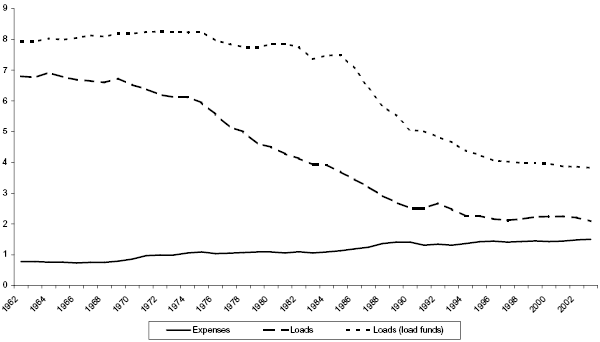Do mutual fund investors pay for performance, or for something else? Are some of them oblivious to fund performance? In their November 2006 paper entitled “Yet Another Puzzle? The Relation between Price and Performance in the Mutual Fund Industry”, Javier Gil-Bazo and Pablo Ruiz-Verdu explore the relationship between mutual fund fees and before-fee performance. Using monthly data for diversified and seasoned U.S. domestic equity mutual funds during 1961-2003 (538,813 fund-month observations), they find that:
- The raw annualized average return before expenses across the entire sample of mutual funds is 10.2%. The annualized average alpha for retail index (managed) funds is -0.27% (-0.85%), with an average expense ratio of 0.83% (1.46%).
- The average annual expense ratio has generally increased over time, while loads have fallen (see chart below).
- The higher a fund’s expense ratio, the worse its before-expenses performance. Specifically, a 1% increase in the annual expense ratio corresponds to a 0.6%-1% reduction in expected annual risk-adjusted returns before expenses.
- Combining loads and expense fees, higher total ownership cost is also negatively and significantly related to before-fee performance.
- The negative relation between fees and performance is not due to index funds, institutional funds, size of fund, type of fund or sub-period anomalies.
- It seems that a significant fraction of mutual fund investors responds slowly or not at all to differences in performance. The mutual fund marketplace apparently disciplines funds targeting sophisticated investors, but neither stops funds with performance-insensitive investors from setting high fees nor drives them quickly out of business.
The following chart, taken from the paper, shows the yearly average mutual fund expense ratio (solid line) and load (dashed line) during 1962-2003. It also displays yearly average load among only those funds charging loads (dotted line). The average expense ratio grows throughout the sample period (from 0.78% in 1962 to 1.5% in 2003), with growth in the late 1980s and 1990s attributable to the incorporation of marketing and distribution costs. Average loads changed little for the first twenty years, and then dropped substantially before leveling off in the 1990s.

In summary, high mutual fund fees may signal poor investment returns, both before and after fees. Investors who focus on low-fee funds may enjoy a double payoff.